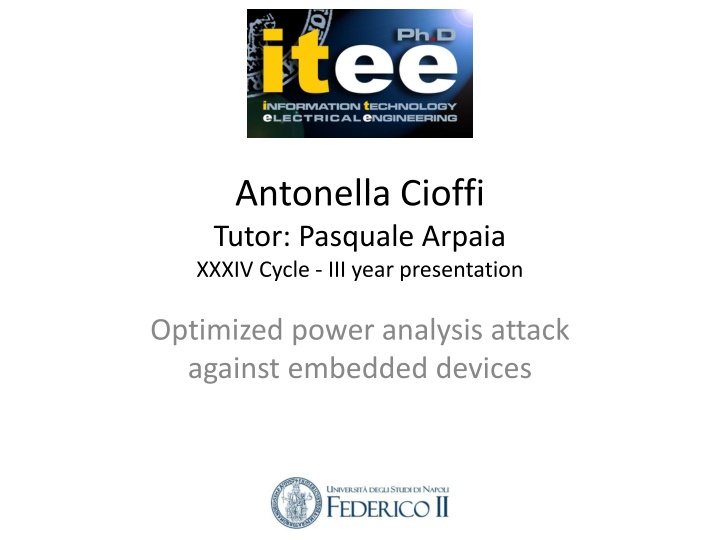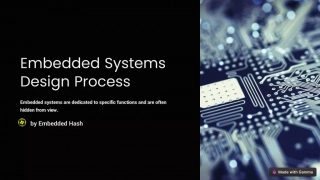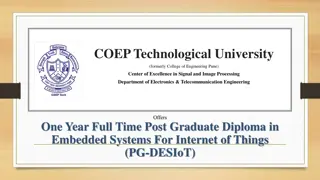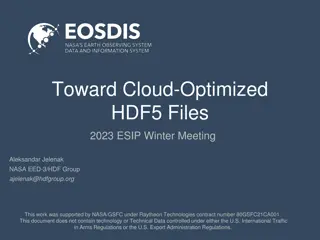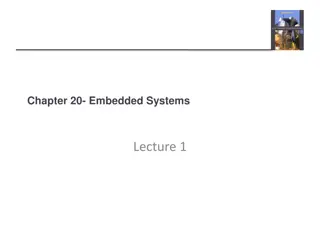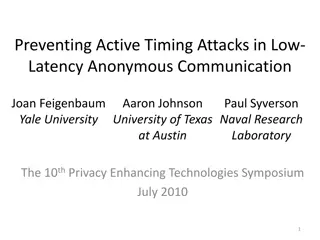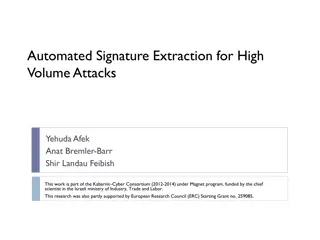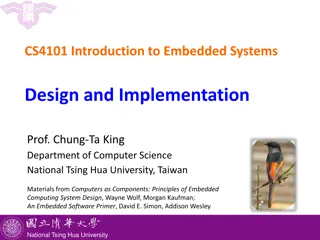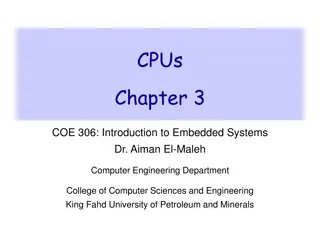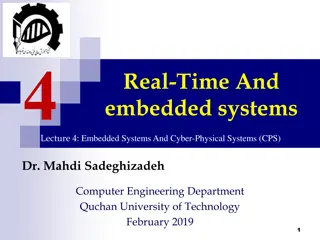Optimized Power Analysis Attacks on Embedded Devices
Graduated with B.Sc. and M.Sc. degrees in Electronic Engineering, currently a Ph.D. student focused on security of embedded devices. Published research on IoT device vulnerabilities and conducted experiments on encryption standards. Collaborated with industry for research. Engaged in third-year research activities exploring side-channel attacks on IoT devices to enhance cybersecurity.
Download Presentation

Please find below an Image/Link to download the presentation.
The content on the website is provided AS IS for your information and personal use only. It may not be sold, licensed, or shared on other websites without obtaining consent from the author.If you encounter any issues during the download, it is possible that the publisher has removed the file from their server.
You are allowed to download the files provided on this website for personal or commercial use, subject to the condition that they are used lawfully. All files are the property of their respective owners.
The content on the website is provided AS IS for your information and personal use only. It may not be sold, licensed, or shared on other websites without obtaining consent from the author.
E N D
Presentation Transcript
Antonella Cioffi Tutor: Pasquale Arpaia XXXIV Cycle - III year presentation Optimized power analysis attack against embedded devices
My background Graduation: B.Sc. degree cum laude in Electronic Engineering at the University of Naples Federico II on October 27, 2016. Thesis: Diagnostica di dispositivi elettronici attraverso l uso di campi elettromagnetici M.Sc. degree cum laude in Electronic Engineering at the University of Naples Federico II on October 25, 2018. Thesis: Metrological characterization of AR-BCI based instrumentation for maintenance in Industry 4.0 Fellowship: PhD Student of XXXIV cycle in Information Technology and Electrical Engineering (ITEE). Theme: Security of embedded devices from side-channel attacks My fellowship is financed by ST Microelectronics. Antonella Cioffi 2
Cooperation Research Group: Prof. Pasquale Arpaia (tutor), Francesco Bonavolont (co-tutor) Cooperation: ST Microelectronics in Marcianise Antonella Cioffi 3
Credit summary Modules: Antonella Cioffi 4
List of pubblications Journal papers: Arpaia, Pasquale, Francesco Bonavolont , and Antonella Cioffi. "Problems of the advanced encryption standard in protecting Internet of Things sensor networks." Measurement 161 (2020): 107853. Arpaia, P., Bonavolont , F., Cioffi, A., & Moccaldi, N. (2021). Power Measurement-based Vulnerability Assessment of IoT medical devices at varying countermeasures for cybersecurity. IEEE Transactions on Instrumentation and Measurement. Arpaia, P., Bonavolont , F., Cioffi, A., & Moccaldi, N. (2021). Reproducibility Enhancement by Optimized Power Analysis Attacks in Vulnerability Assessment of IoT Transducers. IEEE Transactions on Instrumentation and Measurement, 70, 1-8. Angrisani, L., Arpaia, P., Bonavolont , F., & Cioffi, A. (2020, May). Conference papers: Angrisani, L., Arpaia, P., Bonavolont , F., & Cioffi, A. (2020, May). Experimental test of ECDSA digital signature robustness from timing-lattice attack. In 2020 IEEE International Instrumentation and Measurement Technology Conference (I2MTC) (pp. 1-6). IEEE. Arpaia, P., Bonavolont , F., & Cioffi, A. (2020, June). Security vulnerability in Internet of Things sensor networks protected by Advanced Encryption Standard. In 2020 IEEE International Workshop on Metrology for Industry 4.0 & IoT (MetroInd4.0&IoT) (pp. 452-457). IEEE. Antonella Cioffi 5
Third year research activity Context Motivations Methodology Definition of the problem Experiment Result analysis Verification Conclusions Antonella Cioffi 6
Context Currently, the wide availability of commercial off-the-shelf (COTS) IoT devices pose severe security threats. Indeed, an attacker has physical access to these devices and can attempt to address a side-channel attack. Side-channel attacks (SCAs) consist in measuring unintended effects of the cryptographic algorithm computation from an embedded device, as power consumption, electromagnetic radiations, time and heat, to extract sensitive information, as the secret key. Antonella Cioffi 7
Motivation The strength of embedded devices from SCAs is assessed by means of proper vulnerability assessments by security evaluation laboratories. The security level is assessed on the basis of the effort, in terms of computational resources and time, required to break the cryptographic system. A good configuration of the attack allows to correctly assess the security of the embedded devices. Antonella Cioffi 8
Research topic An approach is proposed to optimize the parameter configuration of the attack by: 1. maximizing the number of key bytes correctly discovered. 2. minimizing the cost of the attack in terms of time and resources. Antonella Cioffi 9
Methodology The proposed method is based on the statistical experimental design. Antonella Cioffi 10
Definition of the problem The attack to be optimized is the Correlation Power Analysis (CPA). Each phase of the attack requires specific parameters to be configured: - sampling rate for the acquisition phase - filter weight and resampling frequency for the pre-processing phase - number of power traces for the statistical analysis Antonella Cioffi 11
Definition of the problem We decided to fix the value of the sampling frequency to 250 MSa/s. The values for each parameter were chosen on the base of scientific literature or by signal analysis. Antonella Cioffi 12
Definition of the problem The parameter interaction analysis is carried out to confirm the choice of a linear model for the objective function. The interaction analysis was implemented by the statistical software JMP. Antonella Cioffi 13
Definition of the problem The objective function is the number of disclosed bytes from the CPA. An additive model can be used to represent the dependence of the objective function ( ) from the experimental parameters assumed to be independent. Where is the overall mean of all the j outputs of experiments, iq is the effect of the parameter that the value qth, n is the number of design parameters, and u is the model uncertainty. The goal of the optimization method is to discover the factor levels maximizing the objective function. Antonella Cioffi 14
Experiment planning A L9 orthogonal array was implemented according to the number of parameters Antonella Cioffi 15
Experiment execution The target of the attack is a smart card with the ATMEGA-163 8 bit microcontroller implementing the Advanced Encryption Standard with a 128 bits key length (AES-128). Antonella Cioffi 16
Result analysis The Table reports the mean and standard deviation of the results obtained by 10 repetitions of the attack. From the result Table, the parameter effects on the objective function were identified. Best configuration: Filter weight = 500 Resampling freq. = 500 kSa/s Number of power tracce = 400 Antonella Cioffi 17
Result analysis The ANOVA was conducted to assess the statistical significance of the parameters. All the parameters resulted significant. The Pareto chart highlights the number of power traces as the parameter most significant!!! Antonella Cioffi 18
Verification All the key bytes (16) correctly disclosed is the predicted result in the optimum attack configuration. For the experimental verification, 10 repetitions were implemented. The output of each repetition was 16 bytes correctly revealed. Antonella Cioffi 19
Conclusions The optimization of CPA attack against an embedded device was proposed. The parameters considered for the optimization process were the weight of a fast bidirectional filter and the resample frequency for the pre- processing phase, and the number of power traces for the statistical analysis. The Taguchi L9 fractional design was employed to implement the experiments. The results highlighted an optimum configuration allowing the encryption key to be fully discovered for all the attempts performed with the minimum number of power traces. Antonella Cioffi 20
